溢油分散剂海鸥4msds
- 格式:doc
- 大小:62.50 KB
- 文档页数:9
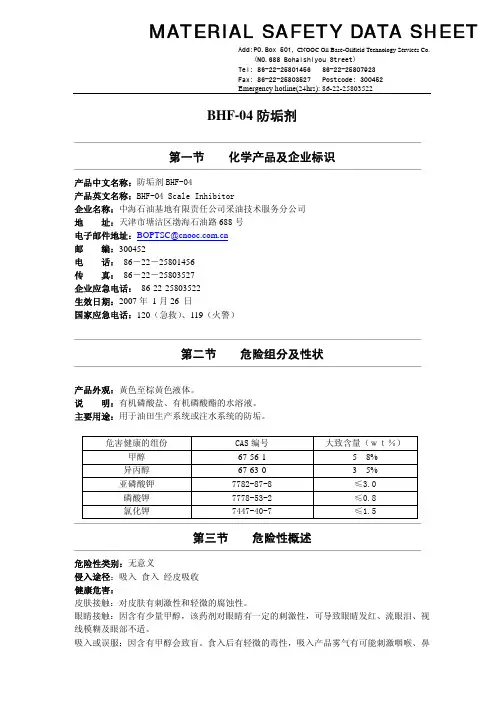
Fax: 86-22-25803527 Postcode: 300452Emergency hotline(24hrs): 86-22-25803522BHF-04防垢剂———————————————————————————————————————第一节 化学产品及企业标识 ———————————————————————————————————————产品中文名称:防垢剂BHF-04产品英文名称:BHF-04 Scale Inhibitor企业名称:中海石油基地有限责任公司采油技术服务分公司地址:天津市塘沽区渤海石油路688号电子邮件地址:BOPTSC@邮编:300452电话:86-22-25801456传真:86-22-25803527企业应急电话:86-22-25803522生效日期:2007年1月26 日国家应急电话:120(急救)、119(火警)———————————————————————————————————————第二节 危险组分及性状 ———————————————————————————————————————产品外观:黄色至棕黄色液体。
说明:有机磷酸盐、有机磷酸酯的水溶液。
主要用途:用于油田生产系统或注水系统的防垢。
危害健康的组份 CAS编号 大致含量(wt%)甲醇 67-56-1 5—8%异丙醇 67-63-0 3—5%亚磷酸钾 7782-87-8 ≤3.0磷酸钾 7778-53-2 ≤0.8氯化钾 7447-40-7 ≤1.5 ———————————————————————————————————————第三节 危险性概述 ———————————————————————————————————————危险性类别:无意义侵入途径:吸入食入经皮吸收健康危害:皮肤接触:对皮肤有刺激性和轻微的腐蚀性。
眼睛接触:因含有少量甲醇,该药剂对眼睛有一定的刺激性,可导致眼睛发红、流眼泪、视线模糊及眼部不适。
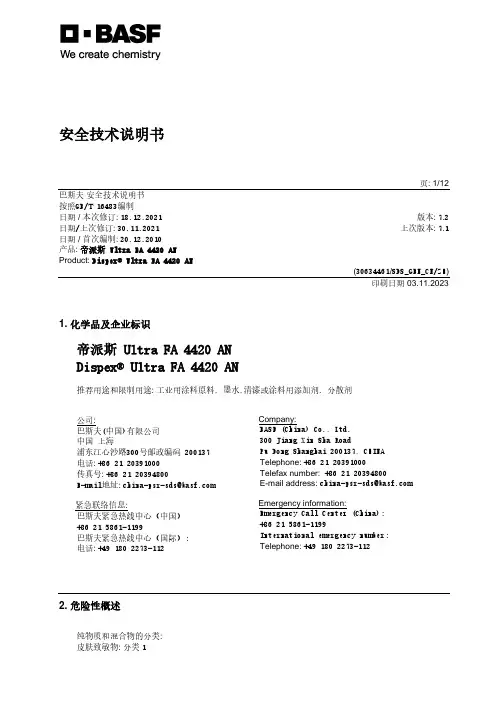
安全技术说明书页: 1/12 巴斯夫安全技术说明书按照GB/T 16483编制日期 / 本次修订: 18.12.2021版本: 7.2日期/上次修订: 30.11.2021上次版本: 7.1日期 / 首次编制: 20.12.2010产品: 帝派斯 Ultra FA 4420 ANProduct: Dispex® Ultra FA 4420 AN(30634461/SDS_GEN_CN/ZH)印刷日期 03.11.20231. 化学品及企业标识帝派斯 Ultra FA 4420 ANDispex® Ultra FA 4420 AN推荐用途和限制用途: 工业用涂料原料, 墨水,清漆或涂料用添加剂, 分散剂公司:巴斯夫(中国)有限公司中国上海浦东江心沙路300号邮政编码 200137电话: +86 21 20391000传真号: +86 21 20394800E-mail地址: **********************紧急联络信息:巴斯夫紧急热线中心(中国)+86 21 5861-1199巴斯夫紧急热线中心(国际):电话: +49 180 2273-112Company:BASF (China) Co., Ltd.300 Jiang Xin Sha RoadPu Dong Shanghai 200137, CHINA Telephone: +86 21 20391000Telefax number: +86 21 20394800E-mail address: ********************** Emergency information:Emergency Call Center (China):+86 21 5861-1199International emergency number: Telephone: +49 180 2273-1122. 危险性概述纯物质和混合物的分类:皮肤致敏物: 分类1巴斯夫安全技术说明书日期 / 本次修订: 18.12.2021版本: 7.2产品: 帝派斯 Ultra FA 4420 ANProduct: Dispex® Ultra FA 4420 AN(30634461/SDS_GEN_CN/ZH)印刷日期 03.11.2023对水环境的急性危害: 分类1对水环境的慢性危害: 分类1标签要素和警示性说明:图形符号:警示词:警告危险性说明:H317可能造成皮肤过敏反应。
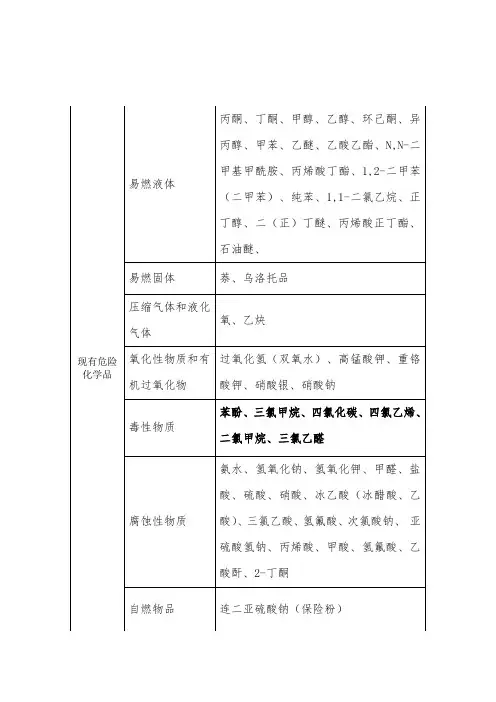
![4-甲基苯乙烯[稳定的]安全技术说明书MSDS](https://uimg.taocdn.com/0741a4c65727a5e9846a6103.webp)
第一部分化学品及企业标识化学品中文名:4-甲基苯乙烯[稳定的]化学品英文名:4-methylstyrene,stabilized;p-methyl styrene化学品别名:对甲基苯乙烯CAS No.:622-97-9EC No.:210-762-8分子式:C9H10分子量:118.18产品推荐及限制用途:用作聚合物单体及用于制造涂料。
第二部分危险性概述紧急情况概述液体。
易燃,其蒸气与空气混合,能形成爆炸性混合物。
对水生物有毒。
GHS危险性类别根据GB30000-2013化学品分类和标签规范系列标准(参阅第十六部分),该产品分类如下:易燃液体,类别3;危害水生环境-急性毒性,类别2。
标签要素象形图警示词:警告危险信息:易燃液体和蒸气,对水生生物有毒。
预防措施:远离热源、热表面、火花、明火以及其它点火源。
禁止吸烟。
保持容器密闭。
容器和接收设备接地和等势联接。
使用不产生火花的工具。
采取措施,防止静电放电。
避免释放到环境中。
戴防护手套/穿防护服/戴防护眼罩/戴防护面具。
事故响应:如皮肤(或头发)沾染:立即去除/脱掉所有沾染的衣服。
用水清洗皮肤或淋浴。
安全储存:存放在通风良好的地方。
保持低温。
废弃处置:按照地方/区域/国家/国际规章处置内装物/容器。
物理化学危险:易燃液体,其蒸气与空气混合,能形成爆炸性混合物。
健康危害:吸入该物质可能会引起对健康有害的影响或呼吸道不适。
意外食入本品可能对个体健康有害。
通过割伤、擦伤或病变处进入血液,可能产生全身损伤的有害作用。
眼睛直接接触本品可导致暂时不适。
环境危害:本品对水生生物有毒。
请参阅SDS第十二部分。
第三部分成分/组成信息√物质混合物第四部分急救措施皮肤接触:立即脱去污染的衣物。
用大量肥皂水和清水冲洗皮肤。
如有不适,就医。
眼睛接触:用大量水彻底冲洗至少15分钟。
如有不适,就医。
吸入:立即将患者移到新鲜空气处,保持呼吸畅通。
如果呼吸困难,给于吸氧。
如患者食入或吸入本物质,不得进行口对口人工呼吸。
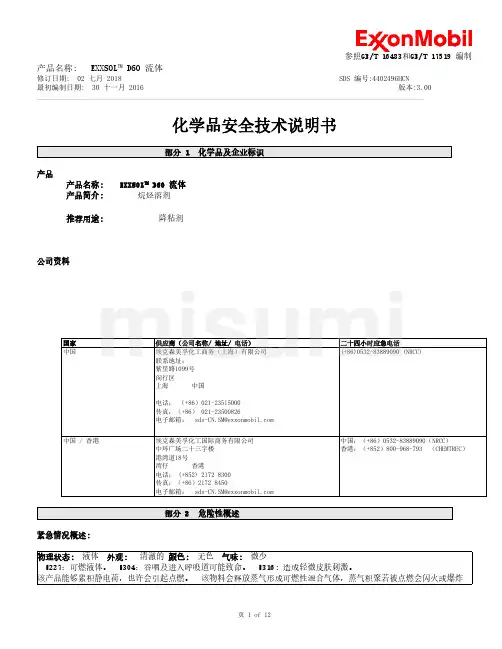
修订日期: 02 七月 2018 SDS 编号:4402496HCN最初编制日期: 30 十一月 2016 版本:3.00______________________________________________________________________________________________________________________化学品安全技术说明书产品产品名称: EXXSOL™ D60 流体产品简介: 烷烃溶剂推荐用途: 降粘剂公司资料国家供应商(公司名称/ 地址/ 电话)二十四小时应急电话中国埃克森美孚化工商务(上海)有限公司联系地址:紫星路1099号闵行区上海 中国电话: (+86)传真:(+86)电子邮箱:中国 / 香港埃克森美孚化工国际商务有限公司中环广场二十三字楼港湾道18号 湾仔 香港电话: (+852) 2172 8300传真:(+86)2172 8450电子邮箱:中国:(+86)(NRCC )香港:(+852)800-968-793 (CHEMTREC )紧急情况概述:物理状态: 液体 外观: 清澈的 颜色: 无色 气味: 微少H227:可燃液体。
H304:吞咽及进入呼吸道可能致命。
H316: 造成轻微皮肤刺激。
该产品能够累积静电荷,也许会引起点燃。
该物料会释放蒸气形成可燃性混合气体,蒸气积聚若被点燃会闪火或爆炸修订日期: 02 七月 2018 SDS 编号:4402496HCN最初编制日期: 30 十一月 2016 版本:3.00______________________________________________________________________________________________________________________可燃反复接触可能使皮肤干燥或龟裂。
对皮肤轻微刺激。
会对眼睛,鼻子,喉咙和肺有刺激。
该物料的危险性分类与化学品分类和危险性公示通则(GB 13690-2009)一致。
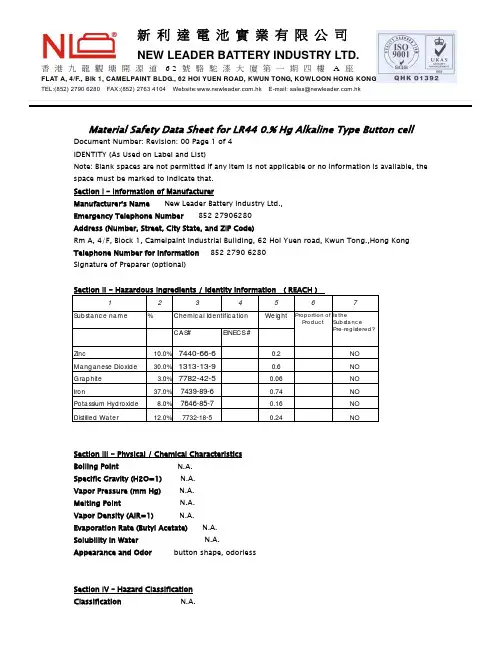
新利達電池實業有限公司NEW LEADER BATTERY INDUSTRY LTD.香港九龍觀塘開源道62號駱駝漆大廈第一期四樓A座FLAT A, 4/F., Blk 1, CAMELPAINT BLDG., 62 HOI YUEN ROAD, KWUN TONG, KOWLOON HONG KONGTEL:(852) 2790 6280 FAX:(852) 2763 4104 Website: E-mail: sales@Material Safety Data Sheet for LR44 0.% Hg Alkaline Type Button cell Document Number: Revision: 00 Page 1 of 4IDENTITY (As Used on Label and List)Note: Blank spaces are not permitted if any item is not applicable or no information is available, the space must be marked to indicate that.Section I – Information of ManufacturerManufacturer's Name New Leader Battery Industry Ltd.,Emergency Telephone Number 852 ********Address (Number, Street, City State, and ZIP Code)Rm A, 4/F, Block 1, Camelpaint Industrial Building, 62 Hoi Yuen road, Kwun Tong.,Hong KongTelephone Number for information 852 2790 6280Signature of Preparer (optional)Section II - Hazardous Ingredients / Identity Information ( REACH )1 23 456 7Substance name % Chemical Identification WeightCAS# EINECS#Proportion ofProductIs theSubstancePre-registered?Zinc 10.0% 7440-66-6 0.2NO Manganese Dioxide 30.0% 1313-13-9 0.6NO Graphite 3.0% 7782-42-5 0.06NO Iron 37.0% 7439-89-6 0.74NO Potassium Hydroxide 8.0% 7646-85-7 0.16NO Distilled Water 12.0% 7732-18-5 0.24NOSection III - Physical / Chemical CharacteristicsBoiling Point N.A.Specific Gravity (H2O=1) N.A.Vapor Pressure (mm Hg) N.A.Melting Point N.A.Vapor Density (AIR=1) N.A.Evaporation Rate (Butyl Acetate)N.A.Solubility in Water N.A.Appearance and Odor button shape, odorlessSection IV – Hazard ClassificationClassification N.A.新利達電池實業有限公司NEW LEADER BATTERY INDUSTRY LTD.香港九龍觀塘開源道62號駱駝漆大廈第一期四樓A座FLAT A, 4/F., Blk 1, CAMELPAINT BLDG., 62 HOI YUEN ROAD, KWUN TONG, KOWLOON HONG KONGTEL:(852) 2790 6280 FAX:(852) 2763 4104 Website: E-mail: sales@Material Safety Data Sheet for LR44 0.% Hg Alkaline Type Button cell Document Number: Revision: 00 Page 2 of 4Section V – Reactivity DataStability Unstable Conditions to AvoidStable Incompatibility (Materials to Avoid)Hazardous Decomposition or ByproductsWhen heated, battery may emit hazardous vapour of KOH/NaOHPolymerization May OccurConditions to Avoid Will Not OccurSection VI - Health Hazard DataRoute(s) of EntryI nhalation N.A.Skin N.A.Ingestion N.A.Health Hazard (Acute and Chronic) / Toxicological informationIn case of electrolyte leakage, skin will be itchy when contaminated with electrolyte.In contact with electrolyte can cause severe irritation and chemical burns.Inhalation of electrolyte vapors may cause irritation of the upper respiratory tract and lungs.Section VII – First Aid MeasuresFirst Aid Procedures If electrolyte leakage occurs and makes contact with skin, wash with plenty of water immediately.If electrolyte comes into contact with eyes, wash with copious amounts of water for fifteen (15)minutes, and contact a physician.If electrolyte vapors are inhaled, provide fresh air and seek medical attention if respiratory irritation develops. Ventilate the contaminated area.Section VIII - Fire and Explosion Hazard DataFlash Point (Method Used) N.A.Ignition Temp N.A.Flammable Limits N.A.LEL N.A.UEL N.A.Extinguishing MediaCarbon Dioxide, Dry Chemical or Foam extinguishersSpecial Fire Fighting Procedures N.A.Unusual Fire and Explosion HazardsDo not dispose of battery in fire - may explode.Do not short-circuit battery - may cause burns.新利達電池實業有限公司NEW LEADER BATTERY INDUSTRY LTD.香港九龍觀塘開源道62號駱駝漆大廈第一期四樓A座FLAT A, 4/F., Blk 1, CAMELPAINT BLDG., 62 HOI YUEN ROAD, KWUN TONG, KOWLOON HONG KONGTEL:(852) 2790 6280 FAX:(852) 2763 4104 Website: E-mail: sales@Material Safety Data Sheet for LR44 0.% Hg alkaline cell Document Number: Revision: 00 Page 3 of 4Section IX – Accidental Release or SpillageSteps to Be Taken in Case Material is Released or SpilledBatteries that are leaking should be handled with rubber gloves.Avoid direct contact with electrolyte.Wear protective clothing and a positive pressure Self-Contained Breathing Apparatus (SCBA).Section X – Handling and StorageSafe handling and storage adviceThe battery is extremely sensitive to adverse effects of humidity. Be sure to store them in a place which is dry and subject to little temperaturechange. Do not place near the boiler or radiator, nor expose to direct sun light. Do not dispose of the battery in fire. Do not charge the battery.Do not short-circuit the battery. Do not put in backward position. Do not store in disorderly fashion, or allow metal objects to be mixed withstored batteries. Do not disassemble the battery, handling in such manner can cause the battery to explose, leak and injury.Section XI – Exposure Controls / Person ProtectionOccupational Exposure Limits: LTEP N.A.STEP N.A.Respiratory Protection (Specify Type) N.A.Ventilation Local Exhausts N.A.Special N.A.Mechanical (General) N.A.Other N.A.Protective Gloves N.A.Eye Protection N.A.Other Protective Clothing or Equipment N.A.Work / Hygienic Practices N.A.Section XII – Ecological InformationN.A.Section XIII – Disposal MethodDispose of batteries according to government regulations.新利達電池實業有限公司NEW LEADER BATTERY INDUSTRY LTD.香港九龍觀塘開源道62號駱駝漆大廈第一期四樓A座FLAT A, 4/F., Blk 1, CAMELPAINT BLDG., 62 HOI YUEN ROAD, KWUN TONG, KOWLOON HONG KONGTEL:(852) 2790 6280 FAX:(852) 2763 4104 Website: E-mail: sales@Material Safety Data Sheet for LR44 0.% Hg alkaline cell Document Number: Revision: 00 Page 4 of 4Section XIV – Transportation InformationNEW LEADER batteries are considered to be “Dry cell” batteries and are unregulated for purposes of transportation by the U.S. Department of Transportation (DOT), International Civil Aviation Administration (ICAO), International Air Transport Association (IATA) and International Maritime Dangerous Goods Regulations (IMDG). The only DOT requirement for shipping these batteries is special provision 130 which states : “Batteries, dry are not subject to the requirements of this subchapter only when they are offered for transportation in a manner that prevents the dangerous evolution of heat (For example, by the effective insulation of exposed terminals). The only requirements for shipping these batteries by ICAO and IATA is Special Provision A123 which states : “An electrical battery or battery powered device having the potential of dangerous evolutions of heat that is not prepared so as to prevent a short-circuit (e.g. in the case of batteries, by the effective insulation of exposed terminals; or in the case of equipment, by disconnection of the battery and protection of exposed terminals) is forbidden from transportation.” The international Maritime Dangerous Goods Code (IMDG) regulate them for ocean transportation under Special Provision 304 which says : Batteries, dry, containing corrosive electrolyte which will not flow out of the battery if the battery case is cracked are not subject to the provision of this Code provided the batteries are securely packed and protected against short-circuits. Example of such batteries are : alkali-manganese, zinc-carbon, nickel metal hydride and nickel-cadmium batteries.Non-dangerous goods. Such battery have been packed in inner packaging in such a manner as to effectively prevent short circuit and movement that could lead to short circuit.Section XV – Regulatory InformationSpecial requirement be according to the local regulatory.Section XVI – Other InformationThe data in this Material Safety Data Sheet relates only to the specific material designated herein.Section XVII – Measures for fire extinctionIn case of fire, it is permissible to use any class of extinguishing medium on these batteries or their packing material. Cool exterior of batteries if exposed to fire to prevent rupture. Fire fighters should wear self-contained breathing apparatus.。
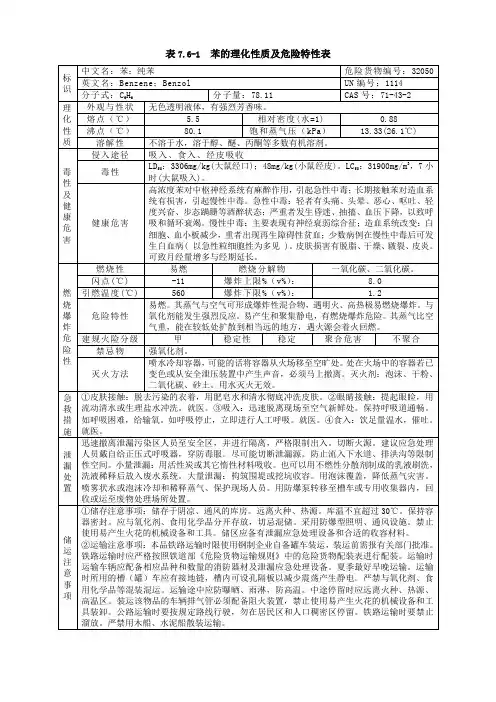
表7.6-1苯的理化性质及危险特性表表7.6-7粗苯的理化性质及危险特性表表7.6-82-丁氧基乙醇的理化性质及危险特性表表7.6-111,4-二甲苯的理化性质和危险特性表表7.6-12二甲苯异构体混合物的理化性质及危险特性表表7.6-14 二甲醚的理化性质及危险特性表7.6-22 环辛烷的理化性质及危险特性表7.6-23 1,2-环氧丙烷的理化性质及危险特性表7.6-24 环氧乙烷的理化性质及危险特性表7.6-25甲苯的理化性质及危险特性表表7.6-26甲醇的理化性质及危险特性表表7.6-272-甲基-1-丙醇的理化性质及危险特性表表7.6-28 2-甲基-2-丙醇的理化性质及危险特性表7.6-29 2-甲基丁烷的理化性质及危险特性表7.6-30甲基叔丁基醚的理化性质及危险特性表表7.6-33 煤油的理化性质及危险特性表7.6-34 汽油的理化性质和危险特性表表7.6-35 柴油的理化性质和危险特性表表7.6-36 溶剂苯的理化性质及危险特性表7.6-37 溶剂油的理化性质及危险特性表7.6-381,2,3-三甲基苯的理化性质及危险特性表表7.6-41石脑油的理化性质及危险特性表表7.6-42石油醚的理化性质及危险特性表7.6-43 石油原油的理化性质及危险特性表7.6-44叔丁基苯的理化性质及危险特性表表7.6-451,2,4,5-四甲苯的理化性质及危险特性表表7.6-46松焦油的理化性质及危险特性表7.6-47 天然气的理化性质及危险特性表7.6-48 液化石油气的理化性质及危险特性表7.6-49乙苯的理化性质及危险特性表表7.6-50 异丁烯的理化性质及危险特性表7.6-51异辛烷的理化性质及危险特性。
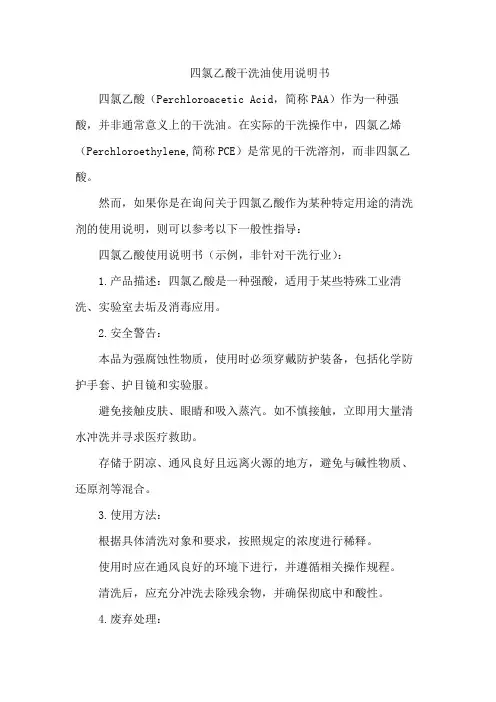
四氯乙酸干洗油使用说明书
四氯乙酸(Perchloroacetic Acid,简称PAA)作为一种强酸,并非通常意义上的干洗油。
在实际的干洗操作中,四氯乙烯(Perchloroethylene,简称PCE)是常见的干洗溶剂,而非四氯乙酸。
然而,如果你是在询问关于四氯乙酸作为某种特定用途的清洗剂的使用说明,则可以参考以下一般性指导:
四氯乙酸使用说明书(示例,非针对干洗行业):
1.产品描述:四氯乙酸是一种强酸,适用于某些特殊工业清洗、实验室去垢及消毒应用。
2.安全警告:
本品为强腐蚀性物质,使用时必须穿戴防护装备,包括化学防护手套、护目镜和实验服。
避免接触皮肤、眼睛和吸入蒸汽。
如不慎接触,立即用大量清水冲洗并寻求医疗救助。
存储于阴凉、通风良好且远离火源的地方,避免与碱性物质、还原剂等混合。
3.使用方法:
根据具体清洗对象和要求,按照规定的浓度进行稀释。
使用时应在通风良好的环境下进行,并遵循相关操作规程。
清洗后,应充分冲洗去除残余物,并确保彻底中和酸性。
4.废弃处理:
废弃的四氯乙酸溶液需按照当地环保法规进行妥善处理,不可随意排放。
由于四氯乙酸并非用于干洗业,因此这里提供的信息仅供参考,不涉及干洗店的实际业务流程。
请在具体使用前详细了解该化学品的产品安全数据表(MSDS)以及相关的专业操作指南。
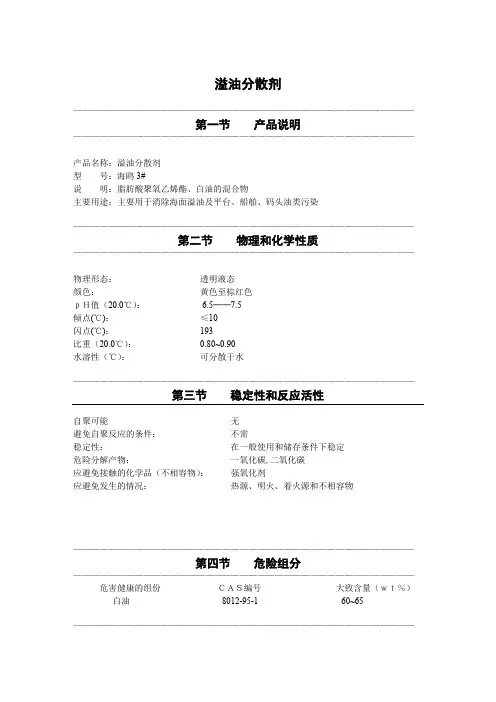
溢油分散剂———————————————————————————————————————第一节产品说明———————————————————————————————————————产品名称:溢油分散剂型号:海鸥3#说明:脂肪酸聚氧乙烯酯、白油的混合物主要用途:主要用于消除海面溢油及平台、船舶、码头油类污染———————————————————————————————————————第二节物理和化学性质———————————————————————————————————————物理形态:透明液态颜色:黄色至棕红色pH值(20.0℃): 6.5──7.5倾点(℃):≤10闪点(℃):193比重(20.0℃):0.80~0.90水溶性(℃):可分散于水———————————————————————————————————————第三节稳定性和反应活性自聚可能无避免自聚反应的条件:不需稳定性:在一般使用和储存条件下稳定危险分解产物:一氧化碳,二氧化碳应避免接触的化学品(不相容物):强氧化剂应避免发生的情况:热源、明火、着火源和不相容物———————————————————————————————————————第四节危险组分———————————————————————————————————————危害健康的组份CAS编号大致含量(wt%)白油8012-95-1 60~65———————————————————————————————————————第五节危险说明———————————————————————————————————————警告! 如误服或吸入对身体有害。
刺激眼睛、皮肤和呼吸道。
物理和化学及火灾和爆炸方面的危害:本产品易燃。
温度在闪点以上时,本品的蒸汽与空气的混合物可以引起爆炸。
分解性。
分解后有易燃/毒性气体生成。
参见第三节“稳定性和反应活性”。
———————————————————————————————————————第六节毒性研究和健康危害———————————————————————————————————————毒性研究国家海洋局北海监测中心对本品的生物毒性进行了检测,对纹缟蝦虎鱼的24小时半致死浓度(24hLC50)>3000mg/L,检测结果符合中华人民共和国行业标准HY 044—1997“海洋石油勘探开发常用消油剂性能指标及检验方法”对生物毒性的要求,具体检验结果如下:健康危害皮肤接触:长时间接触会使皮肤受刺激,若出现皮炎则是因为过敏导致的。

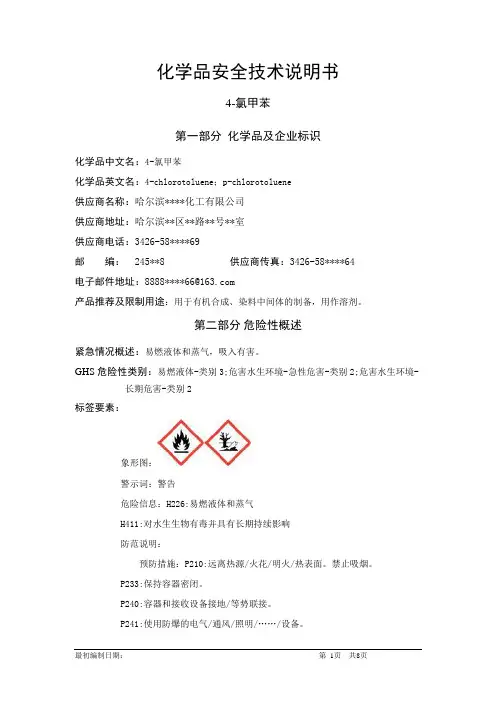
化学品安全技术说明书4-氯甲苯第一部分化学品及企业标识化学品中文名:4-氯甲苯化学品英文名:4-chlorotoluene;p-chlorotoluene供应商名称:哈尔滨****化工有限公司供应商地址:哈尔滨**区**路**号**室供应商电话:3426-58****69邮编:245**8供应商传真:3426-58****64电子邮件地址:8888**************产品推荐及限制用途:用于有机合成、染料中间体的制备,用作溶剂。
第二部分危险性概述紧急情况概述:易燃液体和蒸气,吸入有害。
GHS危险性类别:易燃液体-类别3;危害水生环境-急性危害-类别2;危害水生环境-长期危害-类别2标签要素:象形图:警示词:警告危险信息:H226:易燃液体和蒸气H411:对水生生物有毒并具有长期持续影响防范说明:预防措施:P210:远离热源/火花/明火/热表面。
禁止吸烟。
P233:保持容器密闭。
P240:容器和接收设备接地/等势联接。
P241:使用防爆的电气/通风/照明/……/设备。
P242:只能使用不产生火花的工具。
P243:采取防止静电放电的措施。
P280:戴防护手套/穿防护服/戴防护眼罩/戴防护面具。
P273:避免释放到环境中。
应急响应:P303+P361+P353:如皮肤(或头发)沾染:立即脱掉所有沾染的衣服。
用水清洗皮肤/淋浴。
P370+P378:火灾时,使用……灭火。
P391:收集溢出物。
安全储存:P403+P235:存放在通风良好的地方。
保持低温。
废弃处置:P501:处置内装物/容器……物理和化学危险:易燃,其蒸气与空气混合,能形成爆炸性混合物。
健康危害:本品对眼、呼吸道和皮肤有强烈刺激性。
环境危害:对水生生物有毒并具有长期持续影响。
其他危害:暂无资料。
第三部分成分/组成信息√物质混合物第四部分急救措施急救:- 皮肤接触:立即脱去污染的衣着,用流动清水彻底冲洗。
就医。
- 眼睛接触:立即分开眼睑,用流动清水或生理盐水彻底冲洗。
919型溢油分散剂★使用说明919型溢油分散剂是处理消散流油品,处理环境污染的化学剂,配制方法独特,注重于解除制品毒性和强化渗透,扩散能力以及对油品的乳化消散功能、脱油效应,并可防止溢油火灾。
★特点1、处理的乳化能力强大,稳定性高,可生物降解性好;2、属于“无毒类”产品,有利于保护水产资源;★范围1、处理海洋、港口、江湖河流等水面上的溢流石油污染。
2、对炼油厂冷却水和其它排放含油污水浮油的处理。
3、用于油田排放水浮油的消散处理。
4、用于港口岸壁、船坞、栈桥、船甲板、滩涂、内燃机等各种机械设备外体和油舱、油罐、油管内外壁的脱油清洗,尤其是小管径油管的疏通。
5、用以控制溢油事故的发生。
★方法1、处理水面溢油污染时,用喷洒器具尽量均匀的将本剂洒向浮油(液粒不宜过分雾化),停留15—40分钟后,再经人工或机械(可用船艇航行)进行搅动,使本剂与溢油充分接触、渗透和吸收,即可达到理想的处理效果。
2、清洗机械等外体表面的聚积油时,喷洒本剂后,用工具刷动,再用净水冲洗。
3、用于油舱、油罐、油管内壁脱油时,使用压力泵冲射,然后用水冲洗。
当油层过厚,粘性较大时,选用适度的高压泵操作。
可重复循环冲洗,直到失去效力时,再换新剂。
4、用量比例根据油的品种、厚度及风化程度而定。
通常对于新兴出的稀薄渍层,用量约为溢油的15-30%左右,油层较厚时应采取吸、刮和其它方法尽量回收。
余下1mm左右时再施以本剂。
遇有特殊情况,可继续增加用量,但最多不能超过溢油的一倍以上。
1注意事项远离火源,避免长时间爆晒、高温烘烤和低温冷冻。
★包装大铁桶:200公升铁桶:20公升2。
MATERIAL SAFETY DATA SHEETSECTION 1 CHEMICAL PRODUCT / COMPANY IDENTIFICATIONProduct Name: 2,4-D dimethyl amine salt 720g/L SLMolecular Formula: C8H6Cl2O3Molecular Weight: 221.037Structural Formula:Chemical Name: 2,4-Dichlorophenoxyacetic acidFormulation Type: SL (Soluble Liquid)Appearance: Brown red transparent liquidActive Ingredient : 2,4-D dimethyl amine saltManufacturer: AAddress: ChinaSECTION 2 COMPOSITION /INFORMATION ON INGREDIENTSIngredient CAS Number Content (w/v)2,4-D dimethyl amine salt 2008-39-1 720g/lWater 7732-18-5 Up to 100%SECTION 3 HAZARDS IDENTIFICATIONFAO / WHO hazard classification: WHO IbEmergency Overview:Keep out of reach of children. DANGER. Corrosive. Causes irreversible eye damage. Harmful if swallowed. Avoid inhaling vapor or spray mist. Do not get in eyes or on clothing.Main symptoms:Nausea, headache, tiredness, giddiness, blurred vision and pupillary constriction. Depending on severity of poisoning these symptoms become worse with the onset of vomiting, abdominal pain,diarrhoea, sweating and salivation. Confusion, ataxia, slurred speech, loss of reflexes are some of the central nervous system effects may lead to misdiagnosis of acute alcoholism.Potential Health Effects (on toxicity studies):Likely Routes of Exposure: Inhalation, eye and skin contact.Eyes Contact: Causes irreversible eye damage. Vapors and mist can cause irritation.Skin Contact:This product is considered a minimal skin irritant and is not a dermal sensitizer. Overexposure by skin absorption may cause nausea, vomiting, abdominal pain, decreased blood pressure, muscle weakness, muscle spasms.Ingestion:Harmful if swallowed. May cause nausea, vomiting, abdominal pain, decreased blood pressure, muscle weakness, muscle spasms.Inhalation: Overexposure may cause upper respiratory tract irritation and symptoms similar to those from ingestion.Medical Conditions Aggravated by Exposure:Inhalation of product may aggravate existing chronic respiratory problems such as asthma, emphysema or bronchitis. Skin contact may aggravate existing skin disease.Potential Environmental Effects: Toxic to aquatic invertebratesSECTION 4 FIRST AID MEASURESTRUMPET CONTAINS A CHOLINESTERASE INHIBITOR (NALED). A PHYSICIAN SHOULD BE CONTACTED IN ALL CASES OF EXPOSURE TO NALED AND ITS FORMULATIONS. THIS PRODUCT IS CORROSIVE TO EYES AND SKIN.Eyes Contact:Hold eye open and rinse slowly and gently with water for 15 to 20 minutes. Remove contact lenses, if present, after the first 5 minutes, then continue rinsing eye. Call a poison control center or doctor for treatment advice.Skin Contact:Take off contaminated clothing. Rinse skin immediately with plenty of water for 15 to 20 minutes. Call a poison control center or doctor for treatment advice.Ingestion: Call a poison control center or doctor immediately for treatment advice. Have person sip a glass of water if able to swallow. Do not induce vomiting unless told to do so by the poison control center or doctor. Do not give anything by mouth to an unconscious person.Inhalation: Move person to fresh air. If person is not breathing, call 911 or an ambulance, then give artificial respiration, preferably by mouth-to-mouth, if possible. Call a poison control center or doctor for further treatment advice.NOTE TO PHYSICIANS:This is an Organophosphate (OP) Insecticide. Do not wait for laboratory confirmation to treat patients with strong clinical evidence of poisoning. In the USA and other countries, contact your local or national poison control center for more information.Do not handle the patient without the following protective equipment in place: chemical resistant gloves and apron (preferably nitrile). Remove contaminated clothing and do not reuse without thorough cleaning with detergent and hot water. Dispose of heavily contaminated clothing, including shoes, as a hazardous waste. Establish airway and oxygenation. IV Atropine sulfate is the antidote of choice. Moderately severe poisoning: use 0.4-2.0 mg in adults or 0.05 mg/kg in children. Repeat every 15 minutes until atropinization is achieved. Severe poisoning may require larger doses. Cholinergic toxicity may recur as atropinization wears off; monitor patient closely. Draw blood for RBC and plasma cholinesterase. In addition, Pralidoxime (2-PAM) is indicated during the first 36 hours in severe poisonings. Slow IV administration (no less than 2 minutes) of 1 g in adults or 20-50 mg/kg in children may be repeated in 1 to 2 hours if muscle weakness, twitching, and/or respiratory depression persist. Avoid morphine, aminophylline, phenothiazines, reserpine, furosemide and ethacrynic acid. Bathe and shampoo contaminated skin and hair. If ingested, empty stomach. Due to the presence of aromatic solvents, gastric lavage should be considered following intubation with a cuffed endotracheal tube to prevent aspiration of vomitus. Activated charcoal is useful to further limit absorption.SECTION 5FIRE-FIGHTING MEASURESFlash Point: Will not burn until water component is driven offAuto ignition Temperature: Not determinedFlammability Limits: Not flammableFire and explosion hazard:If water is used to fight fire, contain runoff, using dikes to prevent contamination of water supplies. Dispose of fire control water later.Extinguishing agents:Recommended for large fires: foam or water spray. Recommended for small fires: dry chemical or carbon dioxide.Fire fighting:Firefighters should wear self-contained breathing apparatus and full fire-fighting turn out gear. Dike area to prevent runoff and contamination of water sources. Dispose of fire control water later.Hazardous Decomposition Materials (Under Fire Conditions):Under fire conditions, may produce gases such as hydrogen chloride, nitrogen oxides, and carbon oxides.Personal protective equipment:Fire may produce irritating orpoisonous vapours, mists or other products of combustion. Fire fighters and others that may be exposed should wear full protective clothing and self-contained breathing apparatus.SECTION 6 ACCIDENTAL RELEASE MEASURESPersonal precautions:Wear appropriate protective gear for the situation. See Personal Protection information in Section 8. Environmental precautions:Prevent material from entering public sewer systems or any waterways.Do not flush to drain. Large spills to soil or similar surfaces may necessitate removal of topsoil. The affected area should be removed and placed in an appropriate container for disposal. Occupational spill:Dike spill using absorbent or impervious materials such as earth, sand or clay. Collect and contain contaminated absorbent and dike material for disposal.Methods for Clean-Up and Disposal:Pump any free liquid into an appropriate closed container. Collect washings for disposal. Decontaminate tools and equipment following cleanup. See Section 13: DISPOSAL CONSIDERATIONS for more information.SECTION 7 HANDLING AND STORAGEHandling:Do not get in eyes or on clothing. Avoid inhaling vapor or spray mist. Remove saturated clothing as soon as possible and shower. Wash hands before eating, drinking, chewing gum, using tobacco or using the toilet. Remove clothing immediately, if pesticide gets inside. Then wash thoroughlyand put on clean clothing. Remove Personal Protection Equipment immediately after handling this product. Wash the outside of gloves before removing. As soon as possible, wash thoroughly and change into clean clothing.Storage:Always store pesticides in a secured warehouse or storage building. Store at temperatures above32°F. If allowed to freeze, rewarm to 40°F, remix thoroughly before using. This does not alter this product.Containers should be opened in well-ventilated areas. Keep container tightly sealed when not in use. Do not stack cardboard cases more than two pallets high. Do not store near open containers of fertilizer, seed or other pesticides. Do not contaminate water, food or feed by storage or disposal. SECTION 8 EXPOSURE CONTROLS/PERSONAL PROTECTIONIf this container is five gallons or more in capacity, do not open pour product from this container. A mechanical system (such as a probe and pump or spigot) must be used for transferring the contents of this container. If the contents of a non-refillable pesticide containers are emptied, the probe must be rinsed before removal.PERSONAL PROTECTIVE EQUIPMENT:If engineering controls and work practices are not effective in controlling exposure to this material, then wear suitable personal protective equipment including approved respiratory protection. Respirator:Not normally required. If vapors or mists exceed acceptable levels, wear NIOSH approved air-purifying respirator with cartridges/canisters approved for use against pesticides.Clothing:Employee must wear appropriate protective (impervious) clothing and equipment to prevent repeated or prolonged skin contact with the substance.Gloves:Employee must wear appropriate synthetic protective gloves to prevent contact with this substance. Eye protection:To avoid contact with eyes, wear face shield, goggles or safety glasses with front, brow and temple protection. An emergency eyewash should be readily accessible to he work area.Skin Protection: To avoid contact with skin, wear long pants, long-sleeved shirt, socks, shoes and chemical-resistant gloves. An emergency shower should be readily accessible to the work area. General Hygiene Considerations: Personal hygiene is an important work practice exposure control measure and the following general measures should be taken when working with or handling this material: 1) Do not store, use and/or consume foods, beverages, tobacco products, or cosmetics in areas where this material is stored. 2) Wash hands and face carefully before eating, drinking, using tobacco, applying cosmetics or using the toilet.SECTION 9 PHYSICAL AND CHEMICAL PROPERTIESAppearance: Brown red transparent liquidOdor: OdorlessPH: 7.5Density: 1.201 g/mL after at 54℃for 14aysDensity: 1.201 g/mL after at 54℃for 14aysFlammability: The substance does not ignite, and not propagate combustion either by burning with flame or smouldering.(20±0.1 ℃)Explosive Property: Non-explosive.Solution stability: The test sample is a clear solution after stand for 18 h at 20°C, free from any visible solid particles.(20±0.1 ℃)SECTION 10 STABILITY AND REACTIVITYStability: Considered stable for a period of 2 years in normal air, warehouse and light conditions. Slowly hydrolysed in water and in acidic media, and rapidly hydrolysed by alkalis, to dimethyl hydrogen phosphate and dichloroacetaldehyde.Reactivity: This product is unlikely to react or decompose under normal storage conditions. However, if you have any doubts, contact the supplier for advice on shelf life properties.Incompatibility: No particular incompatibilities.Hazardous polymerization: This product is unlikely to undergo polymerization processes Conditions to avoid: This product should be kept in a cool place, preferably below 30°C.Fire Decomposition: Carbon dioxide, and if combustion is incomplete, carbon monoxide and smoke. Nitrogen and its compounds, and under some circumstances, oxides of nitrogen. Occasionally hydrogen cyanide gas. Hydrogen chloride gas, other compounds of chlorine. Water. Carbon monoxide poisoning produces headache, weakness, nausea, dizziness, confusion, dimness of vision, disturbance of judgment, and unconsciousness followed by coma and death. Hydrogen cyanide poisoning signs and symptoms are weakness, dizziness, headache, nausea, vomiting, coma, convulsions, and death. Death results from respiratory arrest. Hydrogen cyanide gas acts very rapidly; symptoms and death can both occur quickly.SECTION 11 TOXICOLOGICAL INFORMATIONAcute oral LD50: >810 mg/kg (rats)Acute dermal LD50:>5270mg /kg (rats)Acute skin irritation: Non-irritating to skin (rabbits)Acute eye irritation: Moderately to Severely Irritating (rabbits)Skin sensitization: Moderately sensitizing (guinea pig)SECTION 12 ECOLOGICAL AND ECOTOXICOLOGICAL INFORMATIONAquatic toxicity, fishBluegill sunfish (Lepomis macrochirus): Acute toxicity, 96 hours, flowthrough, LC50: 5.8 mg/L Rainbow trout (Oncorhynchus mykiss): Acute toxicity, 96 hours, flowthrough, LC50: 8.2 mg/L Aquatic toxicity, invertebratesWater flea (Daphnia magna): Acute toxicity, 48 hours, static, EC50: 12.9 mg/LAquatic toxicity, algae/aquatic plantsGreen algae (Selenastrum capricornutum): Acute toxicity, 72 hours, static, EC50 (biomass): 2.1mg/L Avian toxicityBobwhite quail (Colinus virginianus): Dietary toxicity, 5 days, LC50: > 5,620 mg/kg dietMallard duck (Anas platyrhynchos): Dietary toxicity, 5 days, LC50: > 5,620 mg/kg dietArthropod toxicityHoney bee (Apis mellifera): Oral/contact, 48 hours, LD50: > 100µg/beSoil organism toxicity, invertebratesEarthworm (Eisenia foetida):Acute toxicity, 14 days, LC50: > 350 mg/kg dry soilN-(phosphonomethyl)glycine (Dichlorvos) BioaccumulationBluegill sunfish (Lepomis macrochirus): Whole fish: BCF: < 1No significant bioaccumulation is expected.DissipationSoil, field: Half life: 2 - 174 days; Koc: 884 - 60,000 L/kg; Binds strongly to soil.Water, aerobic: Half life: < 7 daysSurfactant BiodegradationZahn-Wellens test: Degradation: 80 % within 28 days; Inherently biodegradable.SECTION 13 DISPOSAL CONSIDERATIONSDot not contaminate water, food or feed by storage or disposal.Waste disposal:Pesticide wastes are toxic. If container is damaged or if pesticide has leaked, contain all spillage. Absorb and clean up all spilled material with granules or sand. Place in a closed, labeled container for proper disposal. Improper disposal of excess pesticide, spray mixtures, or rinsate is a violation of Federal law and may contaminate ground water. If these wastes cannot be disposed of by use according to label instructions, contact your State Pesticide or Environmental Control Agency, or theHazardous Waste Representative at the nearest EPA regional office for guidance.Container Handling and Disposal:Do not reuse empty container. Triple rinse (or equivalent), adding rinsate to spray tank. Then offer for recycling or reconditioning, or puncture and dispose of in a sanitary landfill, or by other procedures approved by State and local authorities. Plastic containers are also disposable by incineration, or if allowed by State and local authorities, by burning. If burned, stay out of smoke.SECTION 14 TRANSPORT INFORMATIONProper shipping name: Organophosphorus pesticides, liquid, toxic, N.O.S.Transport hazard class: 9UN Number: 3082Packing group: IIIMarine pollutant: YesSECTION 15 REGULATORY INFORMATIONThis product is listed in Institute for the Control of Agrochemicals Ministry of Agriculture, P.R. China (ICAMA). Reg. No.: PD20098496SECTION 16 OTHER INFORMATIONThis MSDS summarizes our best knowledge of the health and safety hazard information of the product and how to safely handle and use the product in the workplace. Each user should read this MSDS and consider the information in the context of how the product will be handled and used in the workplace including in conjunction with other products. If clarification or further information is needed to ensure that an appropriate risk assessment can be made, the user should contact this company. The responsibility for products sold is subject to our standard terms and conditions, a copy of which is sent to our customers and is also available on request.Responsibility for MSDS: AAddress: ChinaTelephone:。
液体。
产品类型应急咨询电话(带值班时间)::企业标识:化学品的推荐用途和限制用途产品代码:43003中国化学事故应急服务 Tel: +86 532 83889090佐敦涂料(张家港)有限公司中国江苏扬子江国际化学工业园南海路39号 215634电话: +86 512 58937988传真: +86 512 58937986Jotun Coatings (Zhangjiagang) Co. LtdNO.39 Nanhai Road Jiangsu Yangtze River International Chemical Industry Park,Jiangsu Province 215634 China Tel: +86 512 58937988Fax: +86 512 58937986中远佐敦船舶涂料(青岛)有限公司中国山东省青岛市高新区春阳路800号总机电话: +86-532-68689888总机传真: +86-532-66726750Jotun COSCO Marine Coatings (Qingdao) Co. Ltd.No. 800, Chunyang Road, High-tech Zone, Qingdao, P. R. China Tel: +86-532-68689888Fax: +86-532-66726750产品名称SeaForce Active Plus :水解型自抛光防污漆(P)产品描述:油漆。
易燃液体 - 类别 3急性毒性 (口服) - 类别 4急性毒性 (吸入) - 类别 4皮肤腐蚀/刺激 - 类别 2严重眼损伤/眼刺激 - 类别 1皮肤致敏物 - 类别 1致癌性 - 类别 2生殖毒性 - 类别 2特异性靶器官毒性 一次接触 (呼吸道刺激) - 类别 3特异性靶器官毒性 反复接触 - 类别 2危害水生环境一急性危险 - 类别 1危害水生环境一长期危险 - 类别 1GHS危险性类别:标签要素警示词:危险.危险性说明:H226 - 易燃液体和蒸气。
op4乳化剂分子结构式
OP-4是一种非离子表面活性剂,它通常用作乳化剂和分散剂。
其分子结构式如下所示:
OP-4的分子结构式并不是一个单一的化学结构,因为它是一种商业上的混合物,由不同的化学物质组成。
然而,它通常包含一些疏水基团(通常是烷基或芳基)和一些疏水基团(通常是氧或氮原子)。
这些基团的排列和数量会影响OP-4的乳化和分散性能。
从化学角度来看,OP-4可能包含类似于聚氧乙烯醇(POE)链和烷基苯醚链的结构单元。
这些结构单元在形成乳化剂的过程中可以在水相和油相之间形成界面,从而降低表面张力,使油和水能够均匀地混合在一起。
另外,从应用角度来看,OP-4作为乳化剂,可以在制备乳液、乳霜、乳剂等化妆品中发挥作用。
在工业上,它也常用于油漆、润滑油、农药等产品中,用于稳定乳液系统,改善产品的均匀性和稳定性。
总的来说,OP-4乳化剂的分子结构式是多样的,但其主要作用
是在油水界面降低表面张力,促进油水混合,从而起到乳化和分散的作用。
第一部分化学品及企业标识化学品中文名:四氯化硫化学品英文名:sulphur tetrachlorideCAS No.:13451-08-6分子式:Cl4S产品推荐及限制用途:工业及科研用途。
第二部分危险性概述紧急情况概述固体。
会引起皮肤烧伤,有严重损害眼睛的危险。
有严重损害眼睛的危险。
对呼吸道有刺激作用。
对水生物有剧毒,使用适当的容器,以预防污染环境。
GHS危险性类别根据GB30000-2013化学品分类和标签规范系列标准(参阅第十六部分),该产品分类如下:皮肤腐蚀/刺激,类别1B;眼损伤/眼刺激,类别1;特定目标器官毒性-单次接触:呼吸道刺激,类别3;危害水生环境-急性毒性,类别1。
标签要素-象形图警示词:危险危险信息:造成严重皮肤灼伤和眼损伤,造成严重眼损伤,可能造成呼吸道刺激,对水生生物毒性极大。
预防措施:不要吸入粉尘/烟/气体/烟雾/蒸气/喷雾。
作业后彻底清洗。
只能在室外或通风良好之处使用。
避免释放到环境中。
戴防护手套/穿防护服/戴防护眼罩/戴防护面具。
事故响应:如感觉不适,呼叫中毒急救中心/医生。
沾染的衣服清洗后方可重新使用。
收集溢出物。
如误吸入:将受人转移到空气新鲜处,保持呼吸舒适的体位。
如误吞咽:漱口。
不要诱导呕吐。
如皮肤(或头发)沾染:立即去除/脱掉所有沾染的衣服。
用水清洗皮肤或淋浴。
如进入眼睛:用水小心冲洗几分钟。
如戴隐形眼镜并可方便地取出,取出隐形眼镜。
继续冲洗。
安全储存:存放处须加锁。
存放在通风良好的地方。
保持容器密闭。
废弃处置:按照地方/区域/国家/国际规章处置内装物/容器。
物理化学危险:无资料。
健康危害:吸入粉尘或烟雾(尤其是长期接触)可能引起呼吸道刺激,偶尔出现呼吸窘迫。
腐蚀物能引起呼吸道刺激,伴有咳嗽、呼吸道阻塞和粘膜损伤。
吸入该物质可能会引起对健康有害的影响或呼吸道不适。
意外食入本品可能对个体健康有害。
皮肤直接接触造成严重皮肤灼伤。
通过割伤、擦伤或病变处进入血液,可能产生全身损伤的有害作用。